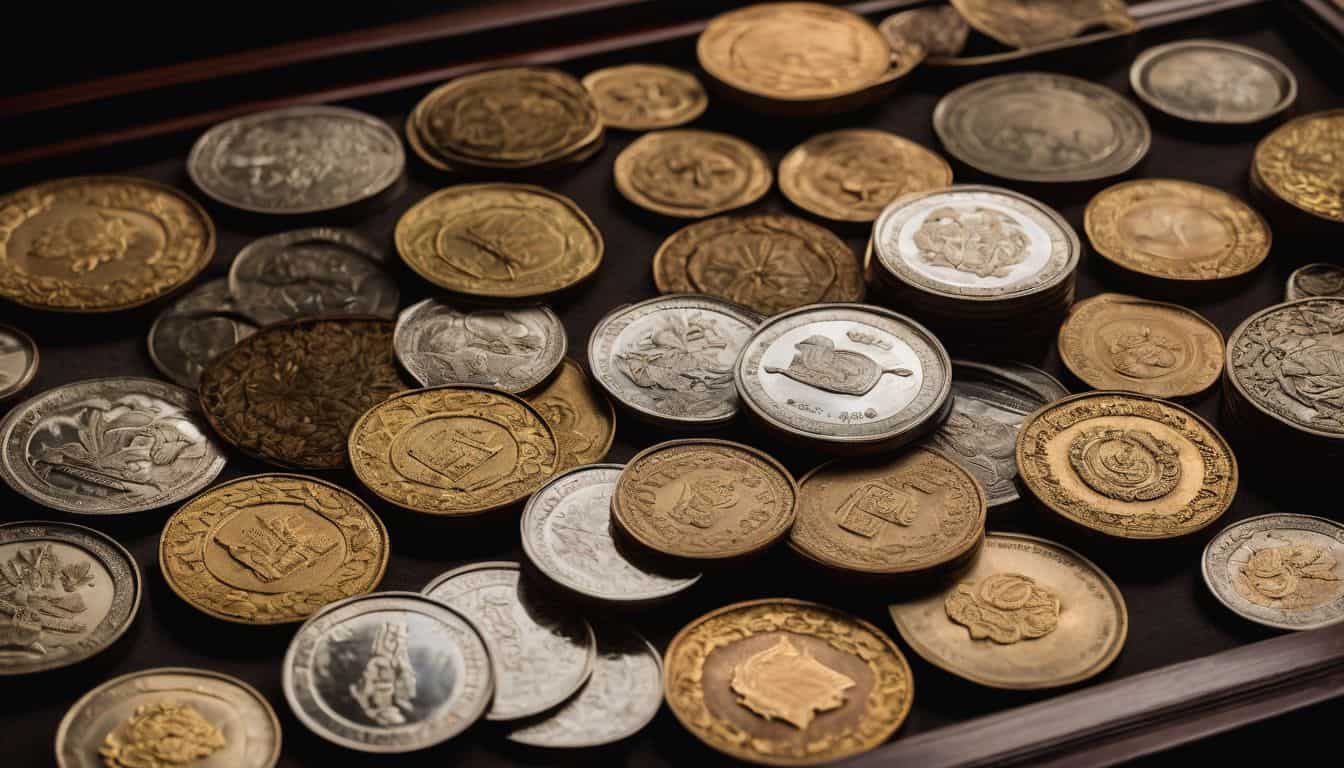Discovering The Fascinating History And Currency Of Bangkok Coins
Are you a coin enthusiast curious about the history of Bangkok coins? It may surprise you to learn that the diverse Thai currency dates back centuries, using unique designs like silver “bullet money” and porcelain gambling tokens.
This detailed blog will guide you on an exciting journey through all eras of this fascinating numismatic heritage, revealing how they evolved into today’s baht and satang. Get ready; it’s time to dive into a treasure chest full of monetary marvels from Bangkok!
Key Takeaways
- Bangkok coins have a rich history dating back centuries, with unique designs like silver “bullet money” and porcelain gambling tokens.
- Thai currency shifted to using decimal coins, where 100 Satang make up one Baht.
- The evolution of Bangkok coins can be seen through different eras, including the early Rama 9 era and the reigns of King Rama 6 and King Rama 7.
- The Thai baht is the official currency of Thailand and is divided into smaller units called satang.
History of Coins in Bangkok

Coins in Bangkok have a rich history, starting from the pre-decimal coinage era to the present day.
Pre-decimal coinage

Bangkok had its own style of coins before using a decimal system. These old coins were like early Indian money, and this shows the strong Hindu impact in Bangkok’s past. In the 13th and 14th centuries, Thai people started using their own kind of coin for the first time.
This period is known as Sukhothai.
They didn’t use machines to make these coins but used their hands instead. Their method was very skillful and unique. They took strips of metal and bent them into round shapes to create each coin piece by piece.
People called this kind of money Pot Duang money. It was an important part of Bangkok’s early history with coins.
Decimal coinage
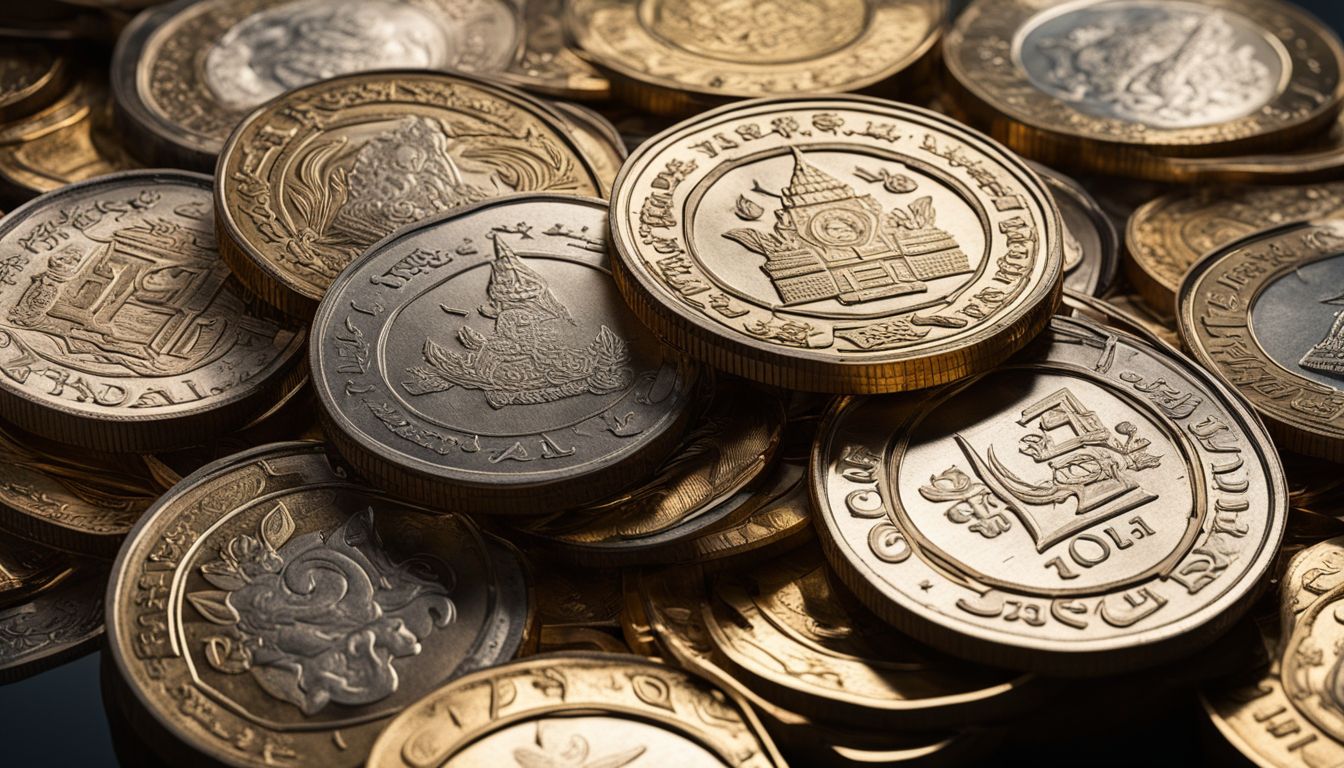 Thailand shifted to using decimal coins. This change took place after the Hindu silver coin models. Decimal coinage is not hard to understand. It means that one Baht can be divided into 100 smaller pieces called Satang.
Thailand shifted to using decimal coins. This change took place after the Hindu silver coin models. Decimal coinage is not hard to understand. It means that one Baht can be divided into 100 smaller pieces called Satang.
So, 100 Satang makes up one Baht.
The Bank of Thailand started this system of money. They are in charge of giving out money in the country. The switch to a decimal system was crucial for Thailand’s economy and trade with other countries.
But, switching was not easy at first. Coins had all kinds of shapes before they became round like we see today. Now they range from small brass coins to large silver ones serving different values under the official currency – Thai Baht.
Early Rama 9 era
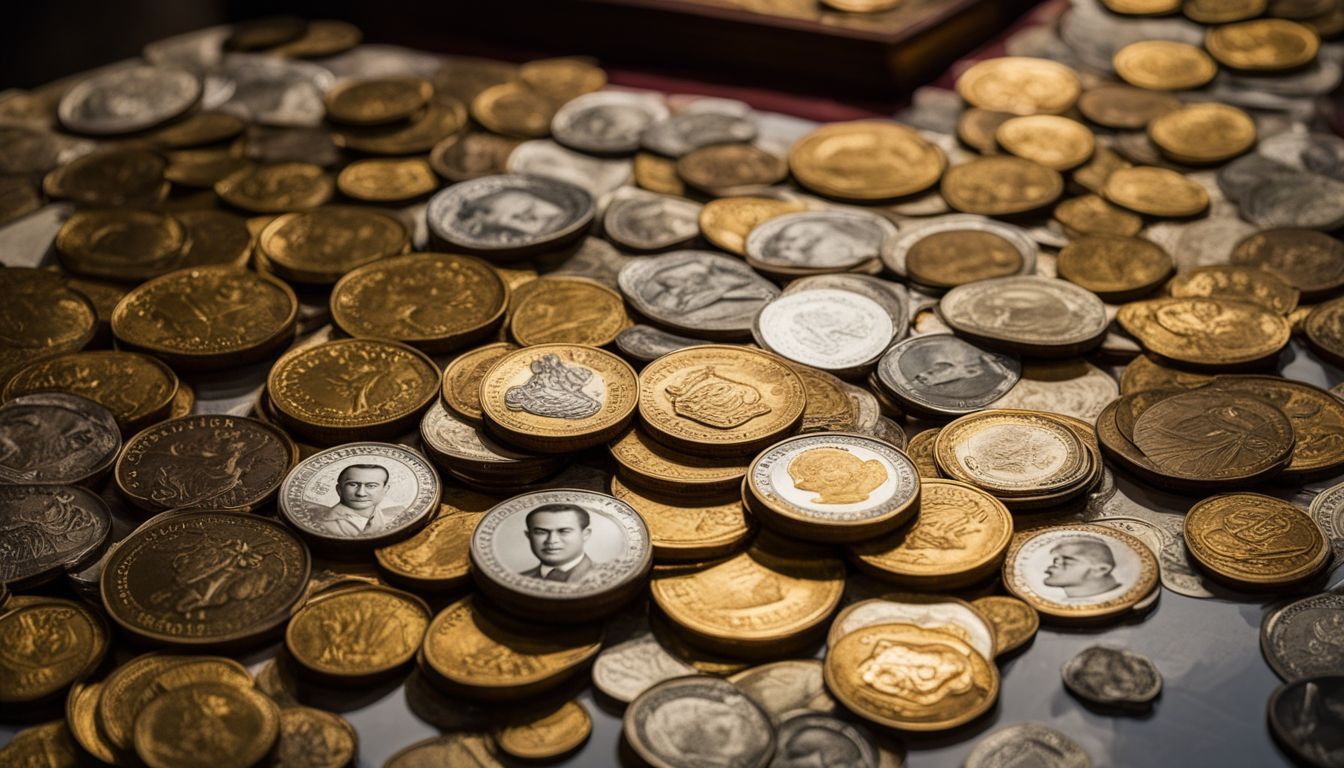 King Rama IX, showcasing various faces, hairstyles, and outfits.” title=”An exhibit featuring coins and banknotes from King Rama IX, showcasing various faces, hairstyles, and outfits.” class=”awimage” />
King Rama IX, showcasing various faces, hairstyles, and outfits.” title=”An exhibit featuring coins and banknotes from King Rama IX, showcasing various faces, hairstyles, and outfits.” class=”awimage” />
King Rama IX had a big part in the early Rama 9 era. He is shown on old Thai money from this time. Both coins and paper notes were used. The Bangkok Coin Museum tells us more about these details.
King Rama IX’s face was put on all types of money.
The early Rama 9 era has close ties with the history of coins in Bangkok. There was a change in how they made money during this time. They added new designs to show King Rama IX’s rule.
In that era, they gave people both coins and banknotes to use as cash.
You can explore more at the Bangkok Coin Museum where you can see these old Thai pieces of currency from this period on display.
Coins during the early Rama 9 era help tell us stories about Thailand then.
They also let us link our past to today’s culture.
It’s nice getting to know these Thai coins – they are important parts of Thai history!
Rama 8 era

During the Rama 8 era in Bangkok’s history, there were significant changes in the currency. This period is associated with important developments in Thai coins and banknotes. The Rattankosin era, particularly King Rama IV’s reign, witnessed major transformations in Thai currency.
These changes played a crucial role in shaping the monetary system that we see today.
Rama 6 and Rama 7 era

During the Rama 6 and Rama 7 era in Bangkok, there were significant reforms and advancements in coins. King Mongkut was responsible for introducing Thailand’s first milled coins, which marked an important step forward in currency development.
However, it wasn’t until the reign of King Rama 7 that these changes gained momentum.
Under the leadership of King Rama 7, a series of progressive reforms were implemented to modernize Siam (now Thailand). These reforms extended to the country’s currency as well. The introduction of new designs and denominations during this era reflected a growing focus on improving the monetary system.
Rama 5 era
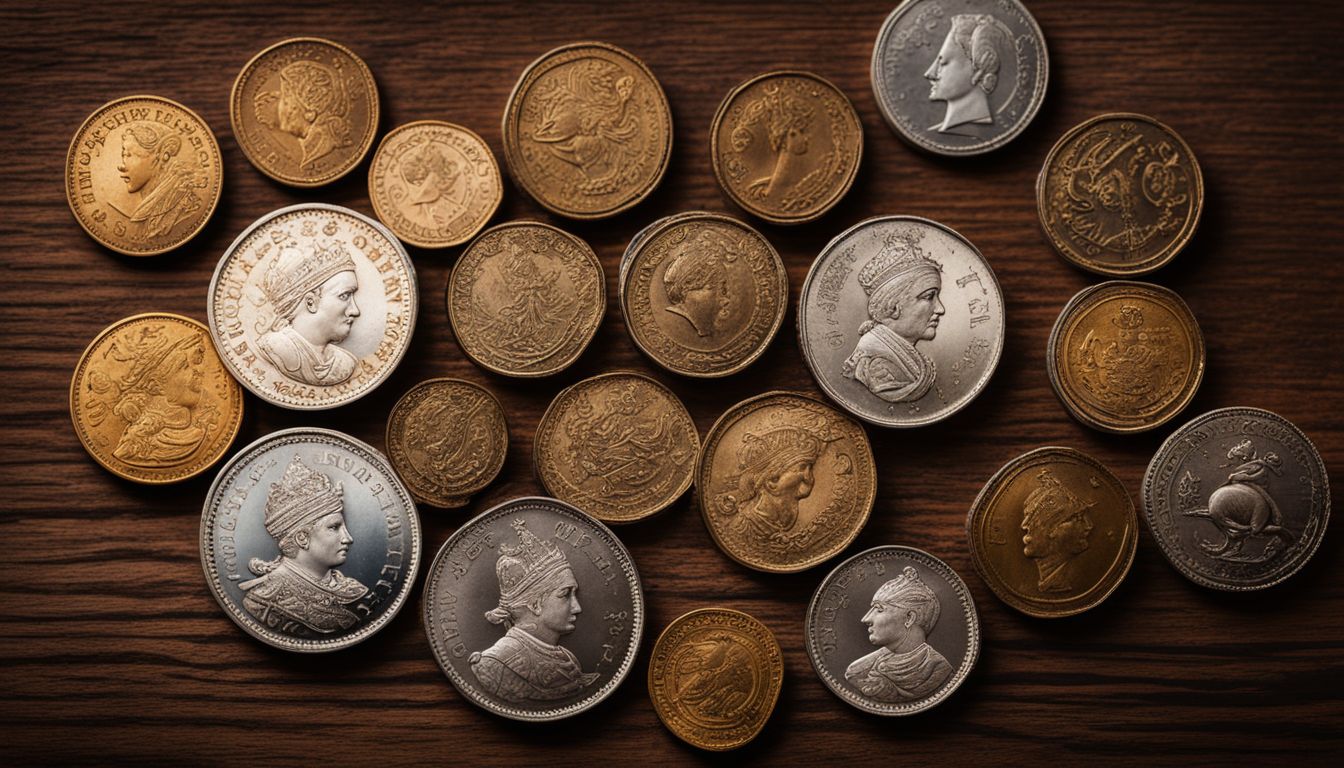
During the Rama 5 era, which was a significant time in the history of Bangkok coins, King Rama III made some important changes to the currency. One of the key developments was the introduction of flat coins.
These were different from previous round-shaped coins and had a more convenient shape for carrying and using in daily transactions. Along with flat coins, silver coins of lesser value were also introduced during this time.
Another notable change occurred during the reign of King Rama VI in the Rama 5 era. He introduced new denominations called Satang coins. These included 10, 5, and 1 Satang coins that were used alongside other Thai baht denominations.
Pre-decimalization era

Before the Thai baht became the official currency of Bangkok, there was a period known as the pre-decimalization era. During this time, different forms of currency were used for trade and transactions.
One interesting example is cowry shells, which were collected from the Mekong River and used as small amounts of currency during the Sukhothai period. In addition to cowry shells, metal strips bent and folded into spheres were also used as a form of money in Bangkok’s early history.
These unique forms of currency demonstrate the creativity and ingenuity of people in finding ways to facilitate trade before standardized coins and banknotes came into existence.
Types of Bangkok Coins

Discover the rich history and variety of Bangkok coins, from the ancient Podduang coins to the modern Thai baht.
Podduang coinage

Podduang coins have a unique history in Siam and its previous kingdoms. These coins were made from bars of silver that were bent, folded, and hammered into shape. They were mainly used during the Sukhothai Kingdom, where round-shaped silver coins known as “pod duang” served as their currency.
To identify their origin and ruler, these podduang coins were stamped with the mark of the ruler.
The process of creating podduang coins involved taking bars of silver and manipulating them to form these unique round shapes. This distinctive method made them easily recognizable among other types of coins used in that era.
Today, podduang coins are highly valued by collectors due to their historical significance and craftsmanship.
Thai baht
The Thai baht is the official currency of Thailand. It has been in circulation since 1902 and is divided into 100 satang. The Bank of Thailand is responsible for issuing and managing the baht.
In the past, it used to be pegged to the U.S. dollar, but now it is managed independently by the central bank of Thailand. The baht plays a crucial role in the country’s economy and daily transactions.
Banknotes in Bangkok

Banknotes in Bangkok have evolved from the Rama 5 era to present, showcasing the rich history and culture of Thailand. Read on to learn more about the fascinating banknotes of Bangkok.
Rama 5 era to present
During the Rama 5 era in Bangkok, which was from 1868 to 1910, there were significant changes in the currency. Before this time, Thai money had different designs like beads and other forms.
But during King Rama V’s reign, coinage was streamlined with only two denominations: satang and baht. Paper money was also introduced successfully during this period.
Today, banknotes have come a long way since the Rama 5 era. The evolution of Thai banknotes can be traced back to this time when they were first introduced. The older notes depicted King Rama IX, while newer ones show King Rama X.
The Thai baht remains the currency in circulation since 1902 and is available in various coin denominations like 25 and 50 stang, as well as 1, 2, 5, and 10 baht.
Evolution of Bangkok Coins

From Series 1 to Series 17, Bangkok coins have evolved over time, reflecting the changing history and culture of Thailand.
Series 1 to Series 17
Series 1 to Series 17 represent the different stages of evolution of Bangkok coins. These series mark a significant shift in the medium of exchange in Thailand over time. Around 95% of Bangkok coins feature the chakra as a dynastic mark, symbolizing the king’s authority.
You can learn more about these fascinating coins by visiting the Bangkok Coin Museum, which showcases the history of Thailand’s unique currencies, including coins from Series 1 to Series 17.
Thai currency has a long and rich history, dating back to ancient times, and these series are an important part of that story. In addition to coins, Thai currency also includes banknotes featuring the current king or past kings like King Rama IX, depending on when they were issued.
Significance of Thai Baht
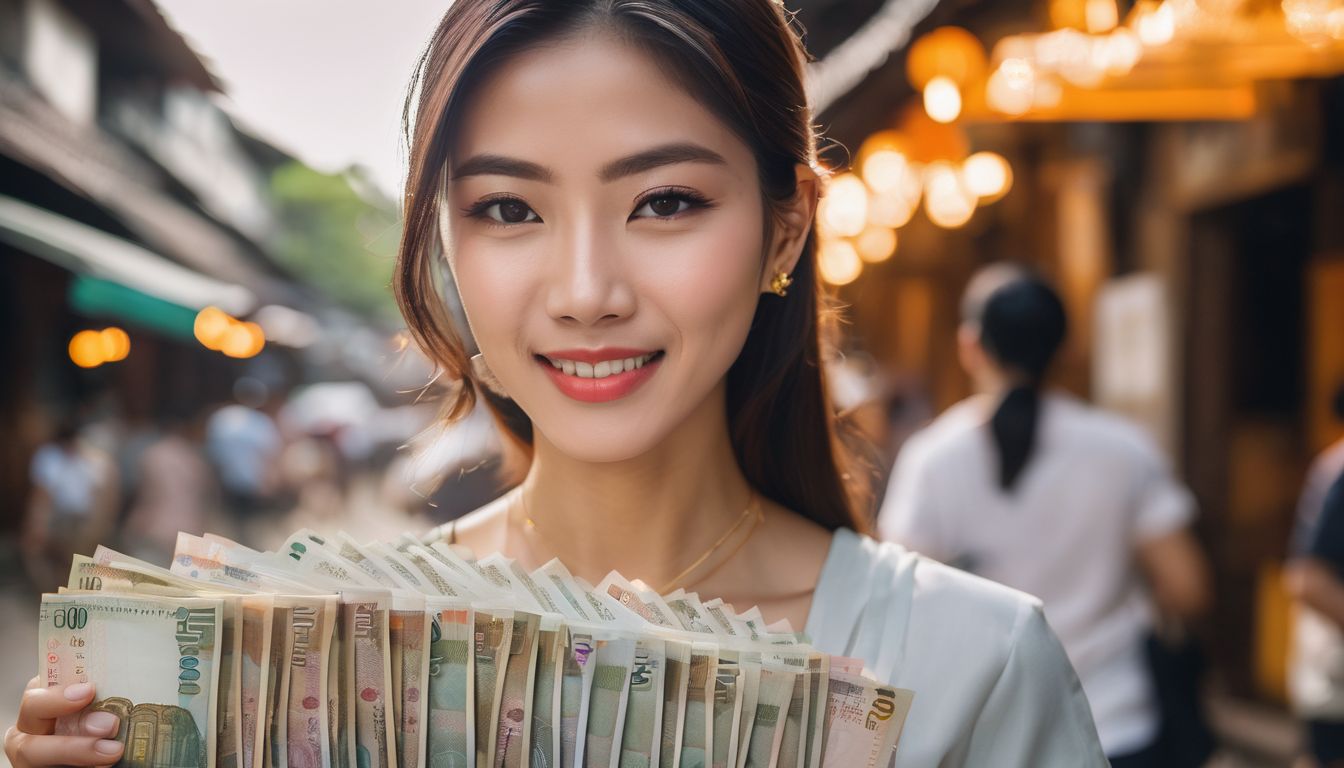
The Thai Baht holds significant importance as it is the official currency of Thailand and is used for everyday transactions in the country.
Currency of Thailand
The currency of Thailand is called the Thai baht. It has been the official currency since 1902. The Thai baht is divided into smaller units called satang, with 100 satang equal to one baht.
There are coins available in denominations of 1, 2, 5, 10, 25, and 50 satangs. These coins are used for small transactions like buying snacks or paying bus fares. The Bank of Thailand is responsible for issuing currency in the country and ensuring its stability.
In the past, the Thai baht was pegged to the U.S. dollar but now it is a floating currency that can fluctuate in value compared to other currencies around the world.
Divisions
The Thai baht is the currency of Thailand, and it is divided into smaller units called satang. One baht equals 100 satang. In Bangkok, you can find coins in denominations of 1, 2, 5, 10, 25, and 50 satang.
These coins are used for making small transactions like buying snacks or paying for transportation fares.
Thai people often use cash for their daily expenses rather than relying on cards. So these coins come in handy when they need to buy something quickly or give exact change. The smaller denominations like the 1 and 2 satang coins are not commonly used anymore due to their low value and the overall price increase over time.
Money and Unit of Mass
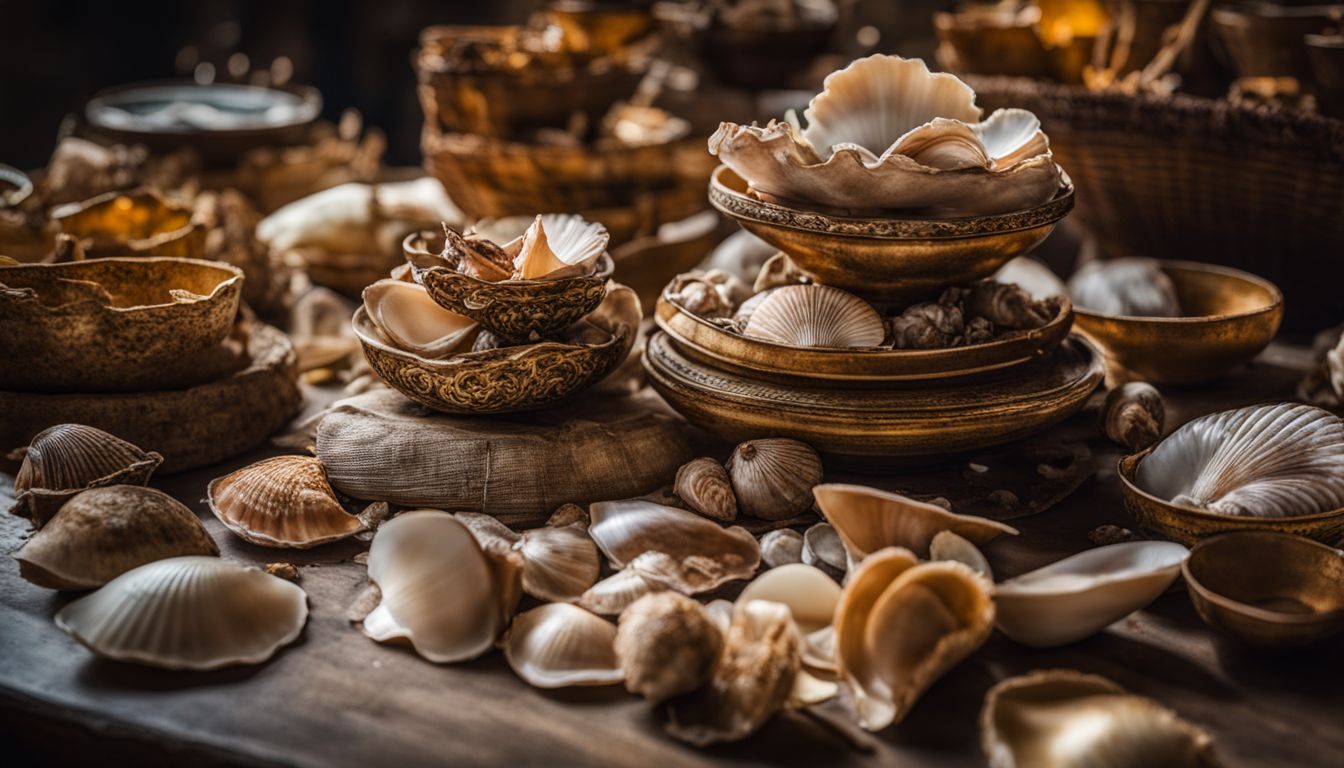
The Thai baht, the currency of Thailand, has an interesting history. Did you know that it used to be a unit of weight or mass? Before banknotes and coins were introduced, Thailand used shells as money.
The Thai baht originated in 1902 and has since become the official currency of the country. Today, Thai currency consists of both coins and banknotes featuring images of the king. If you’re interested in learning more about Thai currencies, visit the Bangkok Coin Museum where you can explore their fascinating history firsthand.
Tips for Changing Money in Bangkok
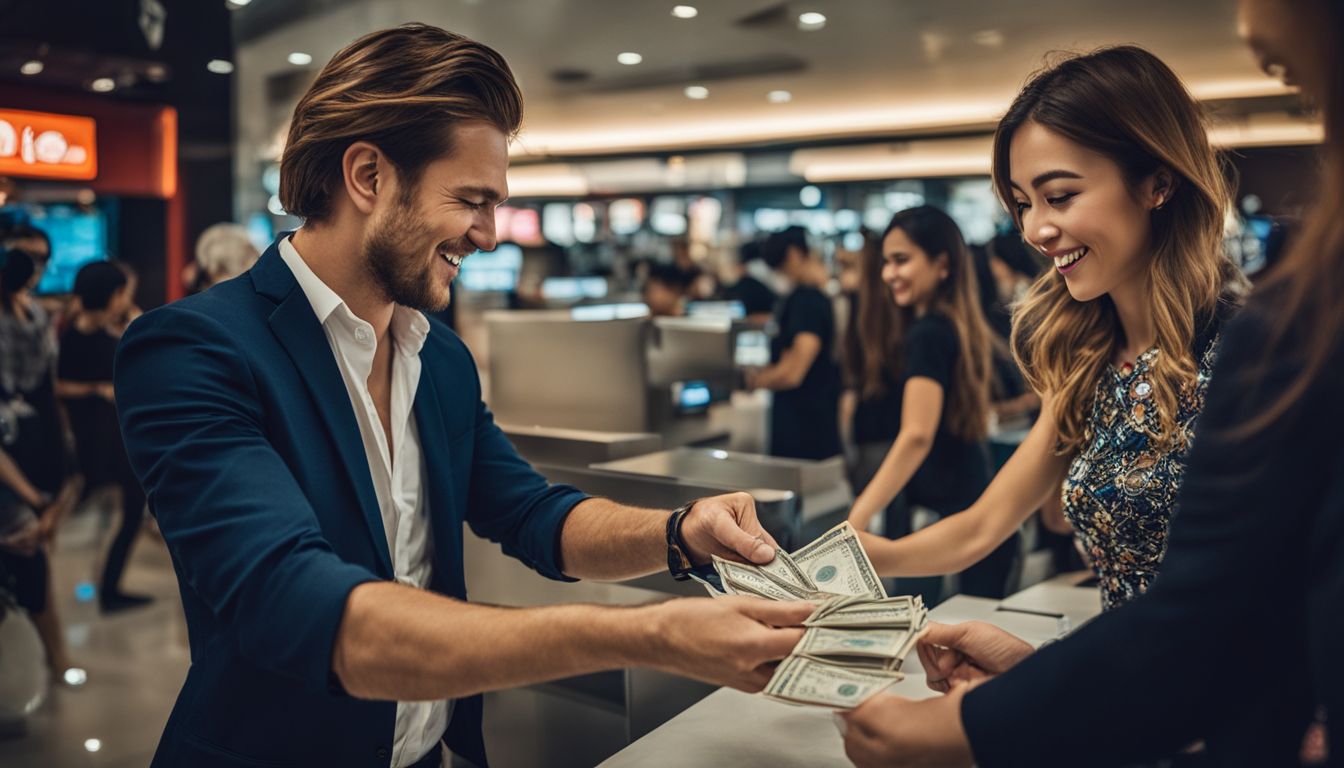
When changing money in Bangkok, it is best to exchange your currency at reputable banks or licensed currency exchange booths for the most favorable rates and avoid scams.
Best places to exchange
If you need to exchange currency in Bangkok, there are a few places that are recommended. Superrich International Exchange is one popular option. They have branches throughout the city and offer competitive exchange rates.
Another good choice is Vasu Exchange Bangkok, which also has multiple locations and provides quick and efficient service. If you’re arriving at Bangkok Suvarnabhumi airport, you’ll find money exchange counters where you can convert your cash.
Banks in the city also offer currency exchange services, so you can visit them for assistance as well. And if convenience is important to you, ATMs are available where you can withdraw Thai baht using your foreign card.
Overall, whether it’s at dedicated currency exchange services like Superrich International Exchange or Vasu Exchange Bangkok, or through banks and ATMs in the city, there are plenty of options for changing your money in Bangkok.
Exchange rates
When changing money in Bangkok, it’s important to consider the exchange rates to get the best value. One well-known money exchange company in Bangkok is Superrich, which has multiple branches across the city, including kiosks in selected BTS stations and full-service exchange centers.
They offer competitive rates and reliable service for currency exchange.
To ensure you’re getting the most value when changing your money, it’s recommended to compare exchange rates from different money changers or banks before making a decision. This will allow you to find the best rate available at that time.
Another option is to withdraw local currency from ATMs in Thailand. However, be aware that some ATMs may charge additional fees for international cards. It’s advisable to check with your bank regarding any foreign transaction fees or charges before making withdrawals.
Using cash or card
When it comes to using cash or card for transactions in Bangkok, you have options that should not be a problem. Many places accept both forms of payment, so you can choose what works best for you.
However, it’s important to keep in mind that if you decide to withdraw cash using a card, there may be fees involved. Be sure to check with your bank before making any withdrawals to avoid unexpected charges.
Interesting Facts About Bangkok Coins
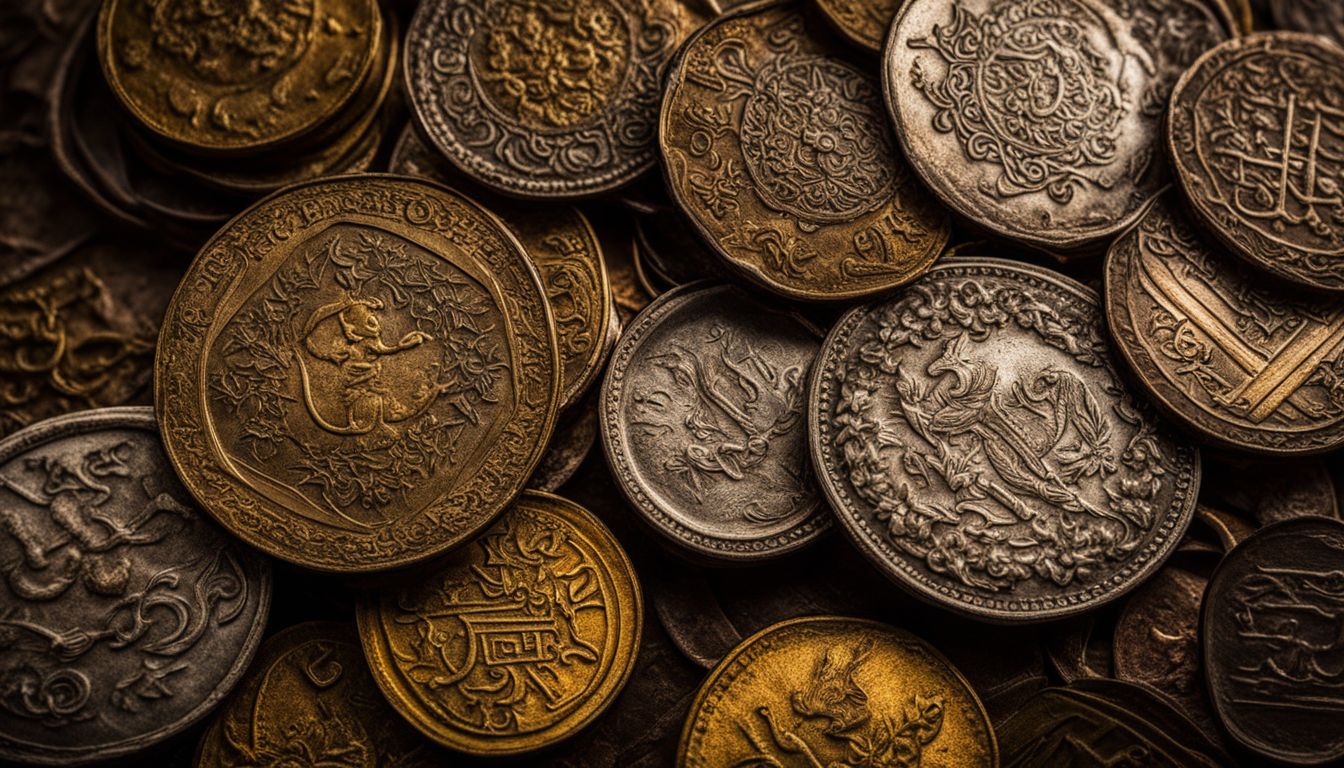
From ancient bullet money to modern Thai baht, Bangkok coins have a rich history and fascinating evolution. Discover the hidden symbols and unique designs that make these coins truly special.
Symbols
Bangkok coins have various symbols that hold significant meaning. One of the symbols is the mark of the chakra, which can be seen on coins from the Bangkok era. This symbol represents the Buddhist Wheel of Law and also signifies the Chakri Dynasty, which is the current ruling dynasty in Thailand.
Another important symbol found on Thai baht coins is an image of the King. It serves as a reminder of the monarchy’s importance in Thai culture and history. Additionally, all temples depicted on Thai Baht coins are located in Bangkok, showcasing its rich heritage and serving as landmarks for locals and tourists alike.
Other Thai coins
Thai coins have a fascinating history and are known for their inscriptions in Chinese, Arabic, and Thai languages. These inscriptions are similar to Chinese coins and showcase the cultural influences on Thai currency.
The use of different scripts highlights the historical connections between Thailand, China, and other Arabic-speaking regions. These inscriptions provide valuable insight into the diverse linguistic heritage of Thailand and add an interesting element to the study of Thai numismatics.
In addition to the unique language aspect, there are also other types of Thai coins that contribute to their rich history. While specific information about these other coins is not provided in the given content, it can be assumed that they vary in design, denomination, and usage.
Conclusion

Discovering the fascinating history and currency of Bangkok coins takes us on a journey through time. From ancient forms of money like silver “bullet money” and porcelain gambling tokens to the modern Thai baht, each coin tells a story.
Exploring the origins, types, and significance of Bangkok coins provides a glimpse into Thailand’s rich numismatic heritage. Whether you’re a coin collector or just curious about currencies, delving into the world of Bangkok coins is sure to spark your interest.
FAQs
1. What is the history of Bangkok coins?
Bangkok coins have a fascinating history that dates back to ancient times when they were first used as a form of currency in the region.
2. Where can I find Bangkok coins?
You can find Bangkok coins in various places such as museums, numismatic exhibitions, coin shops, and online marketplaces specializing in collectible currencies.
3. How can I determine the value of a Bangkok coin?
The value of a Bangkok coin depends on factors such as its rarity, condition, age, and historical significance. It’s best to consult with experts or reference specialized catalogs for accurate valuation.
4. Are there any famous or rare Bangkok coins?
Yes, there are famous and rare Bangkok coins that collectors seek due to their historical importance or unique features. Examples include commemorative editions or those from significant periods in Thai history.
5. Is collecting Bangkok coins a popular hobby?
Yes, collecting Bangkok coins is a popular hobby among numismatists (coin collectors) who appreciate the historical and cultural significance associated with these unique pieces of currency.
